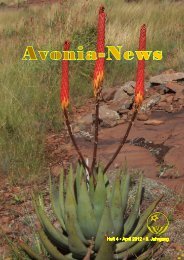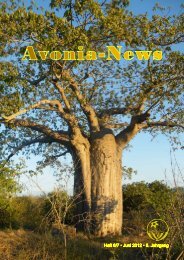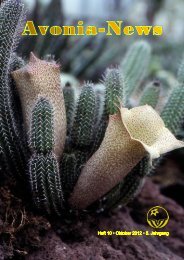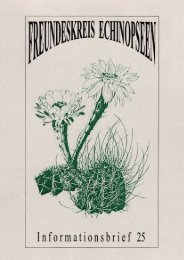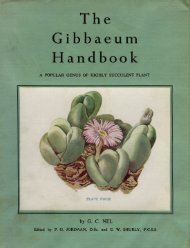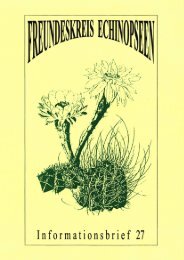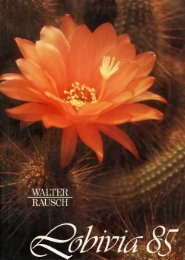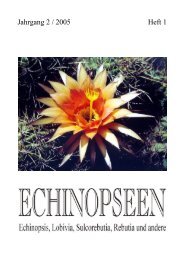Lithops - Au Cactus Francophone
Lithops - Au Cactus Francophone
Lithops - Au Cactus Francophone
Create successful ePaper yourself
Turn your PDF publications into a flip-book with our unique Google optimized e-Paper software.
soil level and are then more easily seen. In the dry state the novice may walk<br />
over them without seeing them. Sometimes they are found embedded in fine<br />
limestone or amongst fine quartz pebbles and then they are not easily found.<br />
I once made a photograph of L. gracilidelineata near Pforte, South West Af<br />
rica, with a very good and large camera. The plant was growing among quartz<br />
pebbles and in the field of vision was a chameleon. This chameleon was used<br />
as a kind of landmark and yet when the negative was developed (Fig. 8) I<br />
have failed to find the plant, although the print has been examined times<br />
without number.<br />
The author has seen a considerable number of <strong>Lithops</strong> in the field<br />
and very rarely has one been seen that has been eaten by animals or even<br />
shows traces of having been nibbled at. The mimicry protagonists will main<br />
tain that that just proves their case, but one fails to see against what ani<br />
mals these plants protect themselves. Protection against undue transpiration<br />
is most likely the reason for the sinking of the bodies of these plants into<br />
the soil. In any case these plants occur very often singly and would not form<br />
adequate nourishment for any animal, how ever small. Frequently one finds<br />
<strong>Lithops</strong> species hidden under bushes or aloes (L. Bromf ieldii). L. Lesliei, on<br />
the other hand, grows in grassy places and in the summer and in winter is<br />
often entirely covered by grass to such an extent that the clump is not visible.<br />
The same applies to L. <strong>Au</strong>campiae. Marloth in his “Stone Plants” refers to<br />
Didymaotus lapidiformis as being a good example of the extent to which these<br />
plants resemble their surroundings. My own experience is that once one has<br />
seen a specimen of Didymaotus in the field, it can be recognised at a distance<br />
of 16 yards, and that is a fairly big distance when it is remembered that the<br />
plant itself is only about an inch or two in diameter and not more than half<br />
an inch in height above the soil level. Even <strong>Lithops</strong> species are not always<br />
difficult to find as is sometimes stated. It all depends on the stage of growth<br />
of the plant, whether rain has fallen recently or not and whether the observer<br />
has a trained eye. In time of drought the upper surfaces of these plants are<br />
level with the dry and dusty soil and frequently covered with a thin layer of<br />
dust or very loose soil particles of the same colour as the plant, so that they<br />
are then extremely difficult to find.<br />
The question why these plants resemble their surroundings both in form<br />
and in colour has not been answered, and it is extremely doubtful whether it<br />
will ever be answered. It is, of course, quite easy, as has been done by some, to<br />
mount the Pegasus of phantasy and then postulate invisible or mysterious rays<br />
emanating from the soil and then influencing the plant to such an extent as<br />
to resemble it, but then one would be saying farewell to science and entering<br />
the domain of speculation not based on experiment. Why, for example L. Le‑<br />
sliei is rust brown in the reddish soil from ironstone and L. gracilidelineata is<br />
whitish amongst the white quartz pebbles is a problem which still baffles us.<br />
As far as I am concerned, I prefer to say with du Bois Raymond “ignorabimus.”<br />
20




